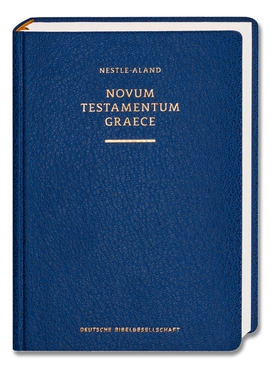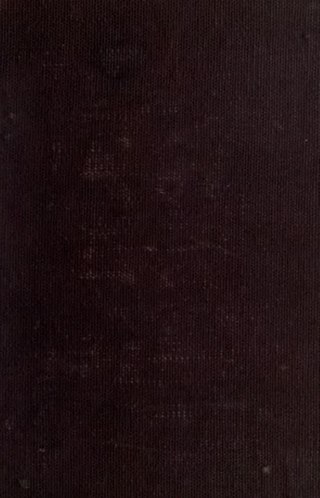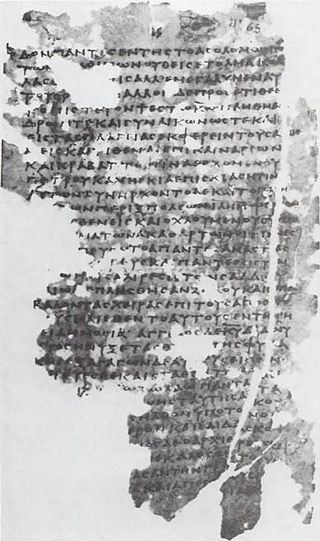Related Research Articles

Lobegott Friedrich Constantin (von) Tischendorf was a German biblical scholar. In 1844, he discovered the world's oldest and most complete Bible dated to around the mid-4th century and called Codex Sinaiticus after Saint Catherine's Monastery at Mount Sinai, where Tischendorf discovered it.

Novum Testamentum Graece is a critical edition of the New Testament in its original Koine Greek, forming the basis of most modern Bible translations and biblical criticism. It is also known as the Nestle–Aland edition after its most influential editors, Eberhard Nestle and Kurt Aland. The text, edited by the Institute for New Testament Textual Research, is currently in its 28th edition, abbreviated NA28.

The New Testament in the Original Greek is a Greek-language version of the New Testament published in 1881. It is also known as the Westcott and Hort text, after its editors Brooke Foss Westcott (1825–1901) and Fenton John Anthony Hort (1828–1892). Textual scholars use the abbreviations "WH" or "WHNU". It is a critical text, compiled from some of the oldest New Testament fragments and texts that had been discovered at the time.

Uncial 030, designated by siglum U or 030, ε 90, is a Greek uncial manuscript of the New Testament on parchment, dated palaeographically to the 9th century. The manuscript has complex contents, with full marginalia.
Codex Seidelianus II designated by He or 013, ε 88, is a Greek uncial manuscript of the four Gospels, dated palaeographically to the 9th century. The manuscript is lacunose.

Codex Coislinianus designated by Hp or 015, α 1022 (Soden), was named also as Codex Euthalianus. It is a Greek uncial manuscript of the Pauline epistles, dated palaeographically to the 6th century. The text is written stichometrically. It has marginalia. The codex is known for its subscription at the end of the Epistle to Titus.

Codex Campianus is designated as "M" or "021" in the Gregory-Aland cataloging system and as "ε 72" in the Von Soden system. It is a Greek uncial manuscript of the New Testament, dated palaeographically to the 9th century. The manuscript has complex contents. It has marginalia and was prepared for liturgical (religious) use.

Eberhard Nestle was a German biblical scholar, textual critic, orientalist, editor of the Novum Testamentum Graece, and the father of Erwin Nestle.

Codex Basilensis A. N. IV. 2, Minuscule 1, δ 254 and formerly designated by 1eap to distinguish it from minuscule 1rK is a Greek minuscule manuscript of the New Testament, usually dated palaeographically to the 12th century CE. It contains the entire New Testament apart from the Book of Revelation.

Minuscule 2814, Aν20, formerly labelled as 1rK in all catalogues, but subsequently renumbered as a 2814 by Aland, is a Greek minuscule manuscript of the New Testament, dated palaeographically to the 12th century.

Minuscule 4, ε 371, is a Greek minuscule manuscript of the New Testament, written on vellum. Using the study of comparative writing styles (palaeography), it has been dated to the 13th century. It was formerly named Codex Regius 84. It has a full collection of marginal marks. It was adapted for liturgical use.
Minuscule 7, ε 287, is a Greek minuscule manuscript of the New Testament, on parchment. Palaeographically it has been assigned to the 12th century.
Minuscule 10, ε 372 (Soden), is a Greek minuscule manuscript of the New Testament, on 275 parchment leaves, dated palaeographically to the 13th century. It has complex contents with full marginalia.
Minuscule 12 (in the Gregory-Aland numbering), A137 (Von Soden), is a Greek minuscule manuscript of the New Testament, on parchment, dated palaeographically to the 14th-century.
Minuscule 70, ε 521, is a Greek minuscule manuscript of the New Testament, on parchment leaves. Palaeographically it has been assigned to the 15th century. The manuscript has complex contents. Marginalia are incomplete.
Codex Ephesinus, minuscule 71, ε 253, is a Greek minuscule manuscript of the New Testament, on parchment, illuminated, and elegantly written. It is dated by the colophon to 1160. In the 15th century the manuscript was prepared for liturgical use. The scribal errors are not numerous, but it has many textual divergences from the common text. The Greek text of the codex is a representative of the Byzantine text-type, but the textual character of the codex is disputed by scholars since the 19th century.

Minuscule 2818, Aπρ20. Formerly it was labelled as 36aK in all catalogues, but it was renumbered by Aland, because two manuscripts had number 36. It is a Greek minuscule manuscript of the New Testament, dated palaeographically to the 12th-century.
Minuscule 614, α 364, is a Greek minuscule manuscript of the New Testament, on parchment. Palaeographically it has been assigned to the 13th century. The manuscript is lacunose. Tischendorf labelled it by 137a and 176p.
Minuscule 629, α 460, is a Latin–Greek diglot minuscule manuscript of the New Testament, on parchment. It is known as Codex Ottobonianus. Palaeographically it has been assigned to the 14th century. The manuscript is lacunose. It is known for the Comma Johanneum.

Uncial 0189, is the oldest parchment manuscript of the New Testament.
References
- ↑ Kenyon, Frederick G. (1939). Our Bible and the Ancient Manuscripts (4th ed.). London: British Museum. p. 118.
- ↑ Metzger, Bruce M.; Ehrman, Bart D. (2005). The Text of the New Testament: Its Transmission, Corruption and Restoration. New York – Oxford: Oxford University Press. p. 172. ISBN 978-0-19-516122-9. Archived from the original on 2013-10-13. Retrieved 2017-09-09.
- 1 2 3 Nestle, Eberhard (1901). Introduction to the Textual Criticism of the Greek New Testament. William Edie (trans). New York: G.P. Putnam's Sons. p. 20.
- 1 2 3 Robert Waltz, Tischendorf's Apparatus [ permanent dead link ]
- ↑ Aland, Kurt; Barbara Aland (1995). The Text of the New Testament: An Introduction to the Critical Editions and to the Theory and Practice of Modern Textual Criticism . Erroll F. Rhodes (trans). Grand Rapids: William B. Eerdmans Publishing Company. p. 13. ISBN 978-0-8028-4098-1.
- 1 2 Aland, Kurt; Barbara Aland (1995). The Text of the New Testament: An Introduction to the Critical Editions and to the Theory and Practice of Modern Textual Criticism . Erroll F. Rhodes (trans). Grand Rapids: William B. Eerdmans Publishing Company. p. 11. ISBN 978-0-8028-4098-1.
- ↑ Aland, Kurt; Barbara Aland (1995). The Text of the New Testament: An Introduction to the Critical Editions and to the Theory and Practice of Modern Textual Criticism . Erroll F. Rhodes (trans). Grand Rapids: William B. Eerdmans Publishing Company. p. 14. ISBN 9780802840981.
- ↑ Aland, Kurt; Barbara Aland (1995). The Text of the New Testament: An Introduction to the Critical Editions and to the Theory and Practice of Modern Textual Criticism . Erroll F. Rhodes (trans). Grand Rapids: William B. Eerdmans Publishing Company. p. 19. ISBN 978-0-8028-4098-1.
- ↑ Metzger, Bruce M.; Ehrman, Bart D. (2005). The Text of the New Testament: Its Transmission, Corruption and Restoration . New York – Oxford: Oxford University Press. p. 173. ISBN 978-0-19-516122-9.
- ↑ Barbara Aland and Beate Küster, The Nestle Edition Archived 2012-03-13 at the Wayback Machine at the Bible Resource Center
- ↑ Kirsopp Lake, The Text of the New Testament (London 1908), pp. 92-93.
- ↑ Philip Comfort, Encountering the manuscripts: an introduction to New Testament paleography, B&H Publishing Group, Nashville, 2005, p. 99.